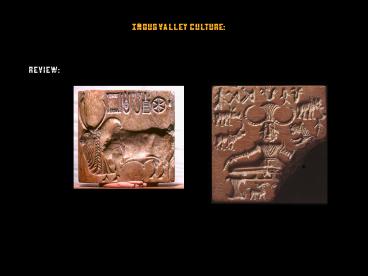PowerPoint Presentation Vedic_Upanishadic PowerPoint PPT Presentation
1 / 21
Title: PowerPoint Presentation Vedic_Upanishadic
1
INDUS VALLEY CULTURE
Review
2
Review Terms Yoga Prana Linga Yogin
Indus Valley Belief System Yoga /
Meditation Unification with Divine Non-duality
3
Shiva linga, 20thc, Banaras
Shiva linga? 3000BC, Harappa
4
Pre-Vedic/Hindu Concepts Unity male (linga)
and Female (yoni) Non-duality divine and
individual Metaphor man vs. cosmos
5
Swastika well being to all
Seal with Swastika, 3000 BCE. Indus Valley
Swastika as symbol of auspiciousness Rajasthan,
NW India
6
Appropriation of Sacred Symbols
7
Decline of the Indus Civilization
- In decline in 1800 BCE
- WHY?
- Indo-Aryan Invasion ?
- Climactic Factors
- Gradual decline more likely
8
Vedic Civilization
- Indo-Aryan Migration 1500 BCE
- Migration from the northwestern areas of Central
Asia - Aryans same groups that also went to Europe
- Distinctive language and ethnic group
- Language Indo-European family SANSKRIT
- - later the sacred language of Hinduism
9
Vedic Civilization1000-500 BCE
- Self-Designation ARYA noble/honorable/first
- Aryans distinctive from the indigenous people,
- in terms of language, religion, and ritual
- Settled in central India dominance over the
Dravidians - DRAVIDIAN vs ARYANS
- Aryan Migration vs Cultural Transformation
- - The sacred Aryan text, Vedas, speak of
subduing - the cities of the their enemies, the
dark-skinned Dasas
10
Vedic Civilization New Ideas and Culture
- SOURCES
- VEDAS vid knowledge
- ? Sanskrit language
- Revealed scriptures SRUTI that which is
heard by the sages - Source of all Hindu tradition
- oral tradition divine in origin revealed to
sages - who were in charge of transmitting this gift to
others - the priests, Brahmans, preserve the text through
oral recitation - with care and accuracy
11
VEDAS
4 Vedas Rig Yajur Sama Atharva 4
Categories (chronological) Samhita Rig Yajur
Sama Atharva Brahmanas Aranyakas Upanishads
12
Rig Veda
- Oldest and most important, composed 1500 BCE
- Hymns to Vedic gods
- Vedic cosmology and ritual
13
Vedic Cosmology and Ritual
Cosmology Golden Embryo (Hiranyagarbha)
Creation of universe sacred primordial world
that was not created but simply self-existed.
Within this realm was the germ of life "golden
embryo/ germ In the beginning, was darkness
swathed in darkness All this was but
unmanifested water Whatever was, that One, coming
into being Hidden by the Void, was generated by
the power of heat (tapas) In the beginning this
One evolved Became desire, first seed of
Mind Wise seers, searching within their
hearts Found the bond of Being in Non-being
14
Hiranyagarbha Golden Embyro
In the beginning the Golden Embryo stirred
and evolved Once born, he was the one Lord of
every being This heaven and earth did he
sustain What god shall we revere with the
oblation?
15
Vedic Ritual
- 1. Yajna (Sacrifice)
- Vedic sacrifice and sharing of meal with each
other - and the gods (devas)
- Fire Sacrifice gods propitiated for material
benefits - Cosmic Order (rta)
- Fire god AGNI
- purification
- mediator between gods and humans
- priest required for sacrifice
- Transports death to the realm of YAMA, the god of
death - , and takes all offering to realm of gods
- Plant god SOMA
- soma drink (ephedra?)
16
(No Transcript)
17
(No Transcript)
18
Vedic Pantheon and Mythology
Devas gods vs. Asuras demons
- Gods
- Gods of the Three Realms
- 1. Heaven sky god, of the night, Varuna
- 2. Atmosphere warrior god Indra, wrathful god
Rudra - 3. Earth Soma, fire god Agni
- 33 Gods of the Vedic pantheon
19
Primordial Man
- VARNA as COSMIC ORDER (Rta)
- VARNA COLOR (Caste System)
- Priests (Brahmins) from mouth of cosmic man
- Warriors (Kshatriyas) from arms
- Common people (Vaisyas) from thighs
- Untouchables (Sudras) from feet)
20
UPANISHADS
- Also called VEDANTA end of the Vedas 600 BCE
- Highly philosophical metaphysical questions
- NEW IDEAS
- SAMSARA notion of rebirth and death as painful
- KARMA
21
UPANISHADS New Ideas
- BRAHMAN atman
- UNIVERSAL individual
- Spiritual Methods
- Contemplation, not ritual
- Meditation
- Ascetism and yoga
- Renunciation of the world
- Detachment of wordly action

